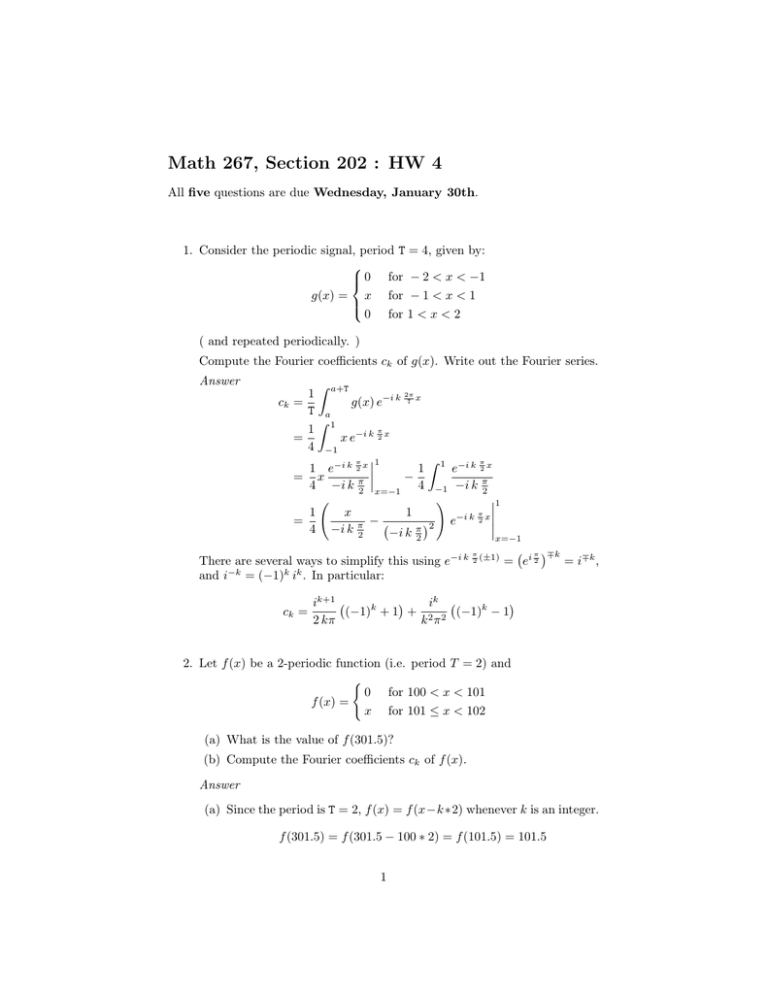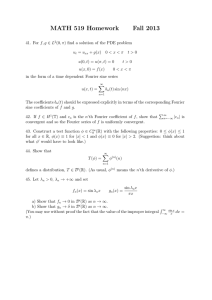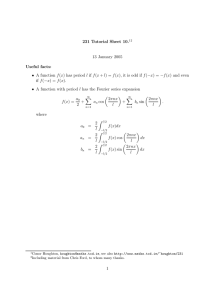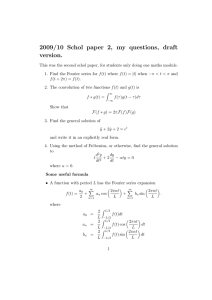Math 267, Section 202 : HW 4
advertisement

Math 267, Section 202 : HW 4 All five questions are due Wednesday, January 30th. 1. Consider the periodic signal, period T = 4, given by: 0 for − 2 < x < −1 g(x) = x for − 1 < x < 1 0 for 1 < x < 2 ( and repeated periodically. ) Compute the Fourier coefficients ck of g(x). Write out the Fourier series. Answer 1 T Z 1 = 4 Z ck = a+T g(x) e−i k a 1 x e−i k 2π T x π 2x −1 1 Z π π 1 e−i k 2 x 1 1 e−i k 2 x x − 4 −i k π2 x=−1 4 −1 −i k π2 1 ! 1 x 1 −i k π x 2 = e − 2 4 −i k π2 −i k π = 2 There are several ways to simplify this using e−i k and i−k = (−1)k ik . In particular: ck = x=−1 π 2 (±1) π = ei 2 ∓k = i∓k , ik+1 ik (−1)k + 1 + 2 2 (−1)k − 1 2 kπ k π 2. Let f (x) be a 2-periodic function (i.e. period T = 2) and ( 0 for 100 < x < 101 f (x) = x for 101 ≤ x < 102 (a) What is the value of f (301.5)? (b) Compute the Fourier coefficients ck of f (x). Answer (a) Since the period is T = 2, f (x) = f (x−k ∗2) whenever k is an integer. f (301.5) = f (301.5 − 100 ∗ 2) = f (101.5) = 101.5 1 (b) 1 T Z 1 = 2 Z ck = a+T f (x) e−i k 2π T x a 102 f (x) e−i k πx 100 =0+ 1 = 2 1 2 Z 102 x e−i k πx 101 −i k πx e e−i k πx x − 2 −i kπ (−i kπ) !102 x=101 To simplify, we will use e−i kπ101 = (−1)k and e−i kπ102 = 1, since 102 · k is even and 101 · k is odd if and only if k is odd. ck = i 1 102 − (−1)k · 101 + 2 2 1 − (−1)k 2kπ 2k π 3. Consider a pair of periodic signals f (t) and g(t), both with period T = 2π. Suppose that all we know is that the Fourier coefficients ck of f (t) and the Fourier coefficients dk of g(t) satisfy: ( ck = dk for −100 ≤ k ≤ 100 , ck = dk + 3−|k| for |k| > 100. Compute Rπ −π |f (t) − g(t)|2 dt. Answer Since f (t) and g(t) both have period T = 2π, then so does h(t) = f (t) − g(t). Moreover: X 2π f (t) = ck ei k T t X 2π k ⇒ f (t) − g(t) = h(t) = (ck − dk ) ei k T t X i k 2π t g(t) = dk e T k k Now forget for a minute where h(t) comes from - it has period 2π, so by Parseval’s theorem ( or orthogonality ): 1 2π Z −π+2π |h(t)|2 dt = −π X |hk |2 k where hk are the Fourier series coefficients for h(t). We found above that, ( 0 for − 100 ≤ k ≤ 100 hk = ck − dk = −|k| −3 for |k| > 100 2 This means: 1 2π Z +π |h(t)|2 dt = −π −101 X 100 ∞ X X −|k| 2 −|k| 2 + 0 + −3 −3 k=−∞ ∞ X =2 k=−100 k=101 3−2|k| k=101 =2 ∞ k X 1 9 1 ∞ k=0 =2 Don’t forget about Z 1 T 1− 9 1 − 91 − 100 k X 1 k=0 ! 9 101 ! 1 − 19 − 1 − 19 from the left side. Conclude that: π Z 2 +π |f (t) − g(t)| dt = −π |h(t)|2 dt = −π π 2 · 9100 4. Consider the function, defined for 0 < x < 2 by: ( 0 for 0 < x < 1 f (x) = 1 for 1 < x < 2 (a) Sketch the graph of even extension, feven (x). (b) Compute the Fourier coefficients ck of the even extension. (c) What is the sum of the resulting Fourier series for x = 2? Give a numeric value. Answer (a) The even extension is +1 for −2 < x < −1, zero for −1 < x < 1, then +1 for 1 < x < 2. This pattern is repeated. The even extension has period T = 4. It is convenient to think of a period as starting at a = −1, because then the first cycle is easy to describe: zero for −1 < x < 1 and +1 for 1 < x < 3. 3 (b) 1 T Z 1 = 4 Z ck = a+T feven (x) ei k 2π T x a −1+4 feven (x) e−i k 2π 4 x −1 =0+ 1 4 Z 3 1 · e−i k π 2x 1 π π i = e−i 3k 2 − e−i k 2 2 kπ π i −i kπ −i k π 2 − e+i k 2 = e e 2 kπ ik+1 (−1)k (−1)k − 1 = 2kπ Z a+T 1 c0 = feven (x) · 1 T a Z 1 3 =0+ 1·1 4 1 1 = 2 Don’t forget to calculate c0 separately! It is not necessary to simplify ck to the level shown. 5. For −1 < x < 1, X 1 3 1 − ei k π x . x = i kπ 2 k 3 π 3 3 k6=0 Rewrite this as a real Fourier series. Answer Use Euler: eikπx = cos(kπx) + i sin(kπx), and split the sum: −1 ∞ X X 1 3 1 3 1 1 x3 = i − − (cos(mπx) + i sin(mπx)) + i (cos(kπx) + i sin(kπx)) mπ 2 m3 π 3 kπ 2 k 3 π 3 m=−∞ k=1 Now flip the sign of m, and match like terms. In particular, note that cos(−kπx) = cos(kπx) and sin(−kπx) = − sin(kπx). ∞ X 3 1 3 1 1 1 3 − − x = i +i cos(kπx) −kπ 2 (−k)3 π 3 kπ 2 k 3 π 3 k=1 ∞ X 3 1 3 1 1 1 − − + −i + i i sin(kπx) −kπ 2 (−k)3 π 3 kπ 2 k 3 π 3 k=1 ∞ X 1 3 1 = (−2) − sin(kπx) kπ 2 k 3 π 3 k=1 4








